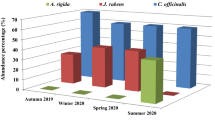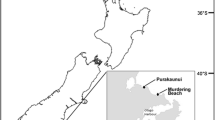Abstract
The brown seaweeds Durvillaea antarctica andD. willana are dominant components of the lowerlittoral and upper sublittoral of exposed rocky shoresin southern New Zealand. Tissue samples of bothspecies, harvested from a site on the south-east coastof South Island over a period of 2 years, wereanalysed for alginate content and composition.Individuals of both species were further separatedinto different blade (lamina and palm) and stipe(cortex and medulla) fractions to assess variationwithin the thallus. On average the alginate contentand frequency of mannuronic acid (Fm) was higherin D. antarctica than in D. willana. Blades contained more alginate than stipes, laminaeand stipes were rich in mannuronic acid whereasholdfasts were rich in guluronic acid. Variations incomposition are considered to reflect the functionaldifferences of the tissue, giving flexibility to bladeand stipe and rigidity to the holdfast. Despitefluctuations in content and composition betweencollection times no seasonal trends in eithercomponent were apparent.
Similar content being viewed by others
References
Black WAP (1948) Seasonal variation in chemical constitution of some of the sub-littoral seaweeds common to Scotland. Part II. Laminaria digitata. J. Soc. Chem. Ind. 67: 355-357.
Black WAP (1950) The seasonal variation in weight and chemical composition of common British Laminariaceae. J. mar. biol. Assoc. U.K. 29: 45-72.
Brasch DJ, Brown MT, McKee JWA, Melton LD (1989) Alginates from New Zealand brown seaweeds. Proc. Inst. prof. Eng. N.Z. Vol. II. Engineering our Natural Resources: 195-204.
Brown MT (1998) The seaweed resources of New Zealand In Critchley AT, Ohno M (eds.), Seaweed Resources of the World, Japan International Cooperation Agency, Yokosuka, pp. 127-137.
Cheshire AC, Hallam ND (1985) The environmental role of alginates in Durvillaea potatorum (Fucales, Phaeophyta). Phycologia 24: 147-153.
Craigie JS, Morris ER, Rees DA, Thom D (1984) Alginate block structure in Phaeophyceae from Nova Scotia: variation with species, environment and tissue type. Carbohydr. Polym. 4: 237-252.
Daly EL, Prince JS (1981) The ecology of Sargassum pteropleuron Grunow (Phaeophyceae, Fucales) in the waters off South Florida. III. Seasonal variation in alginic acid concentration. Phycologia 20: 352-357.
Delépine R, Goubern M, Hubert M (1970) Premières données sur la tenuer en acid alginique des Durvillea dans les Iles australe françaises (Océan Indien) C. r. Acad. Sci. Paris Ser. D 270: 59-62.
Haug A, Larsen B, Baardseth (1969) Comparison of the constitution of alginates from different sources. Proc. int. Seaweed Symp. 6: 443-451.
Haug A, Larsen B, Smidsrød O (1966) A study of the constitution of alginic acid by partial acid hydrolysis. Acta Chem. Scand. 20: 103.
Haug A, Larsen B, Smidsrød O (1974) Uronic acid sequence in alginate from different sources. Carbohydr. Res. 32: 217-225.
Hay CH (1994) Durvillaea (Bory). In Akatsuka I (ed.), Biology of Economic Algae, SPB Academic Publishing, The Hague, The Netherlands, pp. 353-384.
Indergaard M, Skjåk-Bræk G, Jensen A (1990) Studies on the influence of nutrients on the composition and structure of alginate in Laminaria saccharina (L.) Lamour. (Laminariales, Phaeophyceae). Bot mar. 33: 277-288.
Ishikawa M, Nisizawa K (1981) Some enzymatic properties of polymannuronic acid C-5 epimerase in brown algae. Proc. int. Seaweed Symp. 10: 419-424.
King AH (1983) Brown seaweed extracts (alginates). In Glickson M (ed.), Food Hydrocolloids, Volume 2. CRC Press Boca Raton, Florida: 115-188.
Madgwick JC, Ralph BJ (1972) Chemical constituents of Australian bull kelp, Durvillea potatorum. Aust. J. freshwat. Res. 23: 11-16.
Marini-Bettolo GB (1948) Ricerche chimiche sulle alghe del Chile. Nota I. polisaccaridi della Durvillea utilis. Ann. Chim Appl. 38: 294-304.
McHugh DJ (1991) Worldwide distribution of commercial resources of seaweeds including Gelidium. Hydrobiologia 221: 19-29.
McKee JWA, Kavalieris L, Brasch DJ, Brown MT, Melton LD (1992) Alginate content and composition of Macrocystis pyrifera from New Zealand. J. appl. Phycol. 4: 357-369.
Mizuno H, Saito T, Iso N, Onda N (1983) mannuronic to guluronic acid rations of alginic acid prepared from various brown seaweeds. Bull. Jpn Soc. Sci. Fish. 49: 1591-1593.
Moss BL, Naylor M (1954) The chemical composition of the two New Zealand species of Durvillaea. Trans. r. Soc. N.Z. 81: 473-478.
Nalyor M (1953) The New Zealand species of Durvillaea. Trans. r. Soc. N.Z. 80: 277-297.
Nishide E, Kinoshita Y, Anzai H, Uchida N (1988) Distribution of hot-water extractable material, water-soluble alginate and alkali-soluble alginate in different parts of Undaria pinnatifida. Nippon. Suisan Gakkaishi 54: 1619-1622.
Panikkar R, Brasch DJ (1996) Composition and block structure of alginates from New Zealand brown seaweeds. Carbohydr. Res. 293: 119-132.
Panikkar R, Brasch DJ (1997) Biosynthetic implications of NMR analyses of alginate homo-and heteropolymers from New Zealand brown seaweeds. Carbohydr. Res. 300: 229-238.
Parsons MJ (1985) New Zealand seaweed flora and its relationships. N.Z. J. mar. freshwat. Res. 19: 131-138.
Percival E (1979) the polysaccharides of green, red and brown seaweeds: their basic structure, biosynthesis and function. Br. phycol. J. 14: 103-117.
Roberts M (1979) Observations on cell structure and cytology in the genus Durvillaea Bory. N.Z. J. Bot. 17: 241-249.
Rosell KG, Srivastava LM (1984) Seasonal variation in chemical constituents of the brown algae Macrocystis integrifolia and Nereocystis luetkeana. Can. J. Bot. 62: 2229-2236.
South GR (1979) Alginate levels in New Zealand Durvillaea (Pheophyceae), with particular reference to age variation in D. antarctica. Proc. int. Seaweed Symp. 8: 489-498.
South GR, Hay CH (1979) Infuence of wave action and latitude on morphology and standing crop of New Zealand Durvillaea antarctica (Chamisso) Hariot (Phaeophyta, Durvilleales). J. r. Soc. N.Z. 9: 289-296.
Venegas M, Matsuhiro B, Edding ME (1993) Alginate composition of Lessonia trabeculata (Phaeophyta: Laminariales) growing in exposed and sheltered habitats. Bot. mar. 36: 47-51.
Author information
Authors and Affiliations
Rights and permissions
About this article
Cite this article
Kelly, B.J., Brown, M.T. Variations in the alginate content and composition of Durvillaea antarctica and D. willana from southern New Zealand. Journal of Applied Phycology 12, 317–324 (2000). https://doi.org/10.1023/A:1008106723185
Issue Date:
DOI: https://doi.org/10.1023/A:1008106723185




